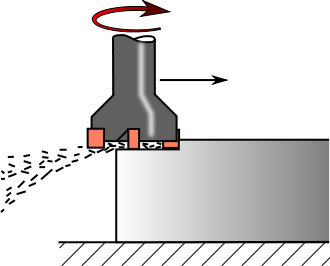'Courageous is he who looks carefully before fleeing.'
African Proverbs
Computer-controlled machining
This is one of the infinite week in the foreseeable future where 'Size Matters'! Though I cannot yet boast of my prowess as a maker, but one thing is certain, and this I say to myself always 'If you maintain your focus, you will be excellent in no time!'. That been said, I will show you a few things I learnt from this week's exercise. Not to forget to mention that the Corona virus invasion has shutdown my lab in Germany. This was also experienced by some other labs across the globe.
What in the world is CNC?
CNC stands for Computer Numerical Control. CNC Machining is a manufacturing process that involves the use of computers to control machine tools. The origin of milling machine was highligthed to date as far back as from the 18th century ( Reference). However, the first NC (Numerical Control) machines were highligthed to be built between the 1940s and 1950s Reference . They were based on existing tools which were modified with motors that moved the tool or part to follow points fed into the system on punched tape. These early servomechanisms were rapidly augmented with analog and digital computers, creating the modern CNC machine tools that have revolutionized machining processes. Tools that can be controlled in this way include lathes, mills, routers and grinders. In our case, though we are not restricted to, but we have to use a Milling machine for this part of the project.
Wikipedia explains is thus: 'Milling is the process of machining using rotary cutters to remove material by advancing a cutter into a work piece. This may be done varying direction on one or several axes, cutter head speed, and pressure. Milling covers a wide variety of different operations and machines, on scales from small individual parts to large, heavy-duty gang milling operations. It is one of the most commonly used processes for machining custom parts to precise tolerances.'
Process
Wikipedia further explains it further: 'Milling is a cutting process that uses a milling cutter to remove material from the surface of a work piece. The milling cutter is a rotary cutting tool, often with multiple cutting points. As opposed to drilling, where the tool is advanced along its rotation axis, the cutter in milling is usually moved perpendicular to its axis so that cutting occurs on the circumference of the cutter. As the milling cutter enters the work piece, the cutting edges (flutes or teeth) of the tool repeatedly cut into and exit from the material, shaving off chips (swarf) from the work piece with each pass. The cutting action is shear deformation; material is pushed off the work piece in tiny clumps that hang together to a greater or lesser extent (depending on the material) to form chips. This makes metal cutting somewhat different (in its mechanics) from slicing softer materials with a blade.'
'The milling process removes material by performing many separate, small cuts. This is accomplished by using a cutter with many teeth, spinning the cutter at high speed, or advancing the material through the cutter slowly; most often it is some combination of these three approaches. The speeds and feeds used are varied to suit a combination of variables. The speed at which the piece advances through the cutter is called feed rate, or just feed; it is most often measured in length of material per full revolution of the cutter. '

This ends the explanation section. To view the assignment, click Assignment or simply go to the assignments sections below.
